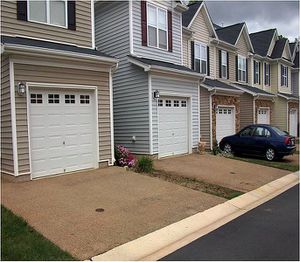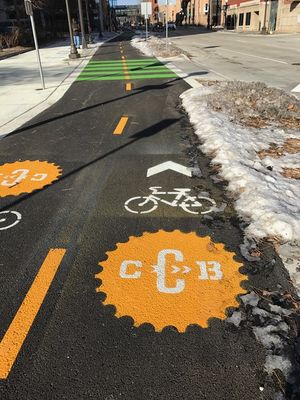
Difference between revisions of "Permeable pavement"
m |
m |
||
| (65 intermediate revisions by 4 users not shown) | |||
| Line 1: | Line 1: | ||
| − | [[File: | + | {{alert|Permeable pavement can be an important tool for retention and detention of stormwater runoff. Permeable pavement may provide additional benefits, including reducing the need for de-icing chemicals, and providing a durable and aesthetically pleasing surface.|alert-success}} |
| + | [[File:mids logo.jpg|300px|right|alt=image of Minimal Impact Design Standards logo]] | ||
| − | + | [[File:picture of porous concrete 1.jpg|thumb|300px|alt=photo illustrating an example of pervious concrete|<font size=3>An example of pervious concrete.</font size>]] | |
| + | [[File:Perm asphalt bikeway.JPG|thumb|300px|alt=permeable asphalt photo|<font size=3>Permeable asphalt bikeway in Germany.</font size>]] | ||
| − | + | Permeable pavements allow stormwater runoff to filter through surface voids into an underlying stone reservoir for temporary storage and/or infiltration. The most commonly used permeable pavement surfaces are pervious concrete, porous asphalt, and permeable interlocking concrete pavers (PICP). Permeable pavements have been used for areas with light traffic at commercial and residential sites to replace traditional impervious surfaces in low-speed roads, alleys, parking lots, driveways, sidewalks, plazas, and patios. While permeable pavements can withstand truck loads, permeable pavement has not been proven in areas exposed to high repetitions of trucks or in high speed areas because its’ structural performance and surface stability have not yet been consistently demonstrated in such applications. | |
| − | From a hydrologic perspective, permeable pavement is typically designed to manage rainfall landing directly on the permeable pavement surface | + | While design details vary, all permeable pavements have a similar structure, consisting of a surface pavement layer, an underlying stone aggregate reservoir layer, optional underdrains and geotextile over uncompacted soil subgrade. From a hydrologic perspective, permeable pavement is typically designed to manage rainfall landing directly on the permeable pavement surface. Permeable pavement surfaces may accept runoff contributed by adjacent impervious areas such as driving lanes or rooftops. The capacity of the underlying reservoir limits the contributing area. Run-on from adjacent vegetated areas is generally not recommended and if it occurs, must be stabilized and not generate sediment as its transport accelerates permeable pavement surface clogging. |
| − | {{alert|'''Sediment control from adjacent impervious or vegetated contributing areas is | + | {{alert|'''Sediment control (pretreatment) from adjacent impervious or vegetated contributing areas is ''HIGHLY RECOMMENDED'' to avoid clogging of the permeable pavement surface'''|alert-warning}} |
| − | '''The individual articles comprising this section on permeable pavement may be viewed as a [[permeable pavement combined|single article]].''' | + | '''The individual articles comprising this section on permeable pavement may be viewed as a [[permeable pavement combined|single article]].''' Note: Due to an unresolved bug, when viewing a formula in a combined article, the math markup (used for equations) is displayed. Please ignore the markup. Thanks. |
| − | + | <font size=3>[[Acknowledgements for permeable pavement|Acknowledgements]]</font size> | |
| − | [[ | ||
| − | < | + | <font size=3><u>'''Permeable pavement articles'''</u></font size> |
| + | *[[Overview for permeable pavement]] | ||
| + | *[[Types of permeable pavement]] | ||
| + | *[[Design criteria for permeable pavement]] | ||
| + | *[[Construction specifications for permeable pavement]] | ||
| + | *[[Assessing the performance of permeable pavement]] | ||
| + | *[[Operation and maintenance (O&M) of permeable pavement]] | ||
| + | *[[Operation and maintenance (O&M) of permeable pavement - supplemental information]] | ||
| + | *[[Calculating credits for permeable pavement]] | ||
| + | *[[Case studies for permeable pavement]] | ||
| + | *[[Green Infrastructure benefits of permeable pavement]] | ||
| + | *[[Summary of permit requirements for infiltration]] | ||
| + | *[[Permeable pavement photo gallery]] | ||
| + | *[[Additional considerations for permeable pavement]] | ||
| + | *[[References for permeable pavement]] | ||
| + | *[[Requirements, recommendations and information for using permeable pavement BMPs in the MIDS calculator]] | ||
| + | *[[Fact sheets for permeable pavement]] | ||
| − | + | Several [[Fact sheets for permeable pavement|fact sheets]] for permeable pavement provide overview information and information on design, construction and maintenance, and volume and pollutant removal. | |
| − | + | ==Related pages== | |
| − | + | *[[Understanding and interpreting soils and soil boring reports for infiltration BMPs]] | |
| − | + | *[[Determining soil infiltration rates]] | |
| − | |||
| − | |||
| − | |||
| − | |||
| − | |||
| − | |||
| − | |||
| − | |||
| − | |||
| − | |||
| − | < | + | <noinclude> |
| − | + | [[Category:Level 3 - Best management practices/Structural practices/Permeable pavement]] | |
| − | + | </noinclude> | |
| − | |||
Latest revision as of 21:06, 22 December 2022
Permeable pavements allow stormwater runoff to filter through surface voids into an underlying stone reservoir for temporary storage and/or infiltration. The most commonly used permeable pavement surfaces are pervious concrete, porous asphalt, and permeable interlocking concrete pavers (PICP). Permeable pavements have been used for areas with light traffic at commercial and residential sites to replace traditional impervious surfaces in low-speed roads, alleys, parking lots, driveways, sidewalks, plazas, and patios. While permeable pavements can withstand truck loads, permeable pavement has not been proven in areas exposed to high repetitions of trucks or in high speed areas because its’ structural performance and surface stability have not yet been consistently demonstrated in such applications.
While design details vary, all permeable pavements have a similar structure, consisting of a surface pavement layer, an underlying stone aggregate reservoir layer, optional underdrains and geotextile over uncompacted soil subgrade. From a hydrologic perspective, permeable pavement is typically designed to manage rainfall landing directly on the permeable pavement surface. Permeable pavement surfaces may accept runoff contributed by adjacent impervious areas such as driving lanes or rooftops. The capacity of the underlying reservoir limits the contributing area. Run-on from adjacent vegetated areas is generally not recommended and if it occurs, must be stabilized and not generate sediment as its transport accelerates permeable pavement surface clogging.
The individual articles comprising this section on permeable pavement may be viewed as a single article. Note: Due to an unresolved bug, when viewing a formula in a combined article, the math markup (used for equations) is displayed. Please ignore the markup. Thanks.
Permeable pavement articles
- Overview for permeable pavement
- Types of permeable pavement
- Design criteria for permeable pavement
- Construction specifications for permeable pavement
- Assessing the performance of permeable pavement
- Operation and maintenance (O&M) of permeable pavement
- Operation and maintenance (O&M) of permeable pavement - supplemental information
- Calculating credits for permeable pavement
- Case studies for permeable pavement
- Green Infrastructure benefits of permeable pavement
- Summary of permit requirements for infiltration
- Permeable pavement photo gallery
- Additional considerations for permeable pavement
- References for permeable pavement
- Requirements, recommendations and information for using permeable pavement BMPs in the MIDS calculator
- Fact sheets for permeable pavement
Several fact sheets for permeable pavement provide overview information and information on design, construction and maintenance, and volume and pollutant removal.
Related pages
This page was last edited on 22 December 2022, at 21:06.


